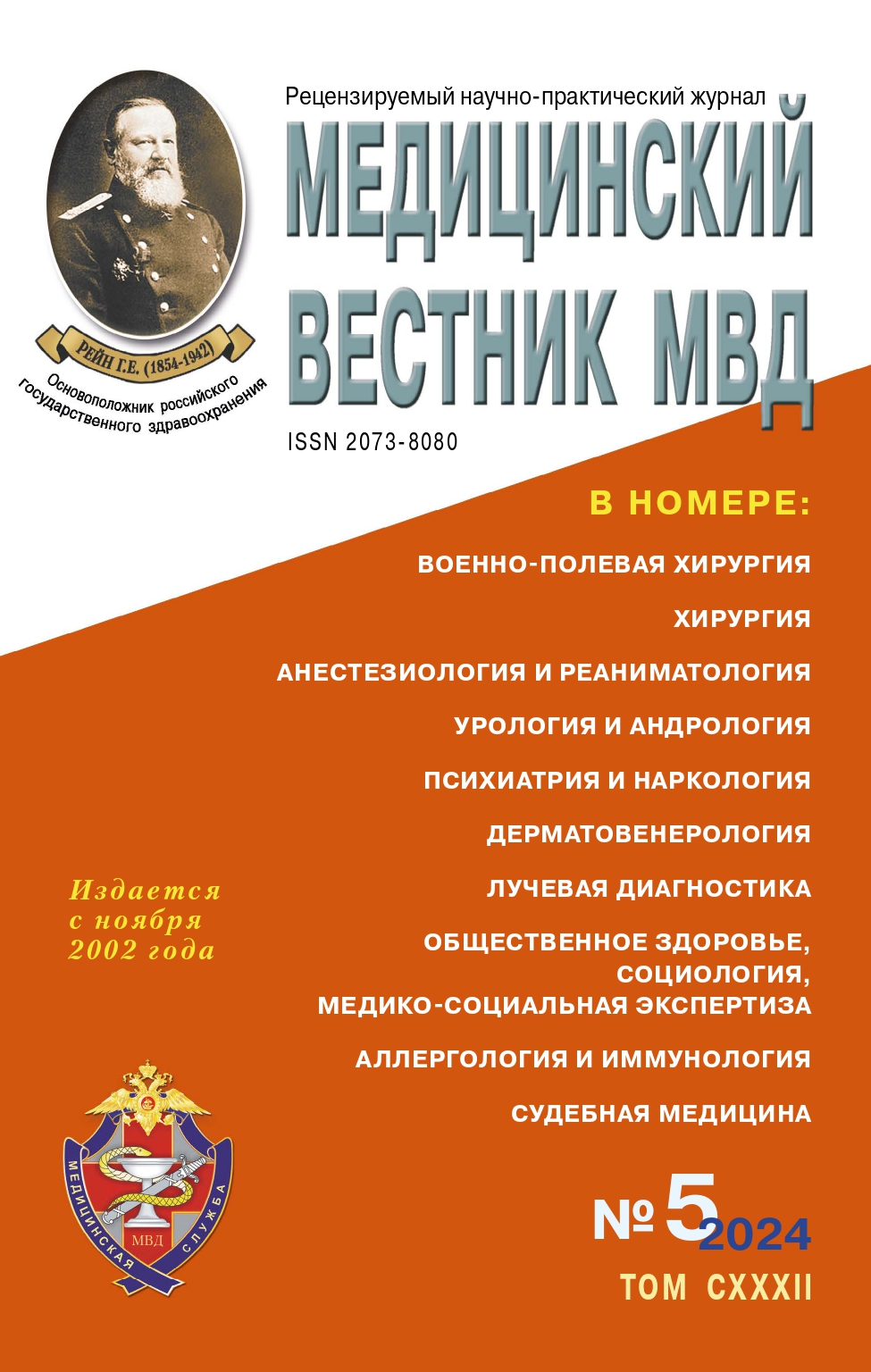Russian Federation
Russian Federation
Russian Federation
Russian Federation
Russian Federation
The paper presents comparative analysis of the results of treatment of the kidney stones up to 2 sm by means of micropercutaneous nephrolithotripsy. It was found that the use of ureteral shell during the surgical intervention improves the treatment efficiency by 16%. The use of ureteral stent was proved to reduce surgical time from 87.9±1.3 min to 71.4±1.4 min when the ureteral shell is applied. The total number of postoperative complications as well as supplementary instrumental interventions was noted to decrease by 16,7%.
urolithiasis, micropercutaneous nephrolithotripsy, efficiency, complications, supplementary interventions
1. Johnston A.W. Nationwide readmission rates following percutaneous nephrolithotomy: does age matter? / A.W. Johnston, R. Jiang, M.H. Alkazemi [et al.] // J. of Endourol. – 2019. – Vol. 9, № 33. – P. 704–711.
2. Yavuz A. Outcomes of different minimally invasive techniques in lower calyceal stones of 1 to 2 centimeters: A prospective, randomized study. Resultados de varias técnicas mínimamente invasivas en litiasis del polo inferior de 1-2 centímetros: estudio prospectivo, randomizado / A. Yavuz, M.F. Kilinc, G. Bayar //Arch Esp Urol. – 2020. – Vol. 73, № 4. – P. 307–315.
3. Hou J. Knowledge-map analysis of percutaneous nephrolithotomy (PNL) for urolithiasis / J. Hou, Z. Lv, Y. Wang [et al.] // Urolithiasis. – 2023. – Vol. 51. – № 1. – P. 34.
4. Bader M.J., Gratzke C., Seitz M., Sharma R., Stief C.G., Desai M. The «all-seeing needle»: initial results of an optical puncture system confirming access in percutaneous nephrolithotomy / M.J. Bader, C. Gratzke, M. Seitz [et al.] // Eur Urol. – 2011. – Vol. 59, № 6. – P. 1054–1059.
5. Desai M.R. Single-step percutaneous nephrolithotomy (microperc): the initial clinical report / M.R. Desai, R. Sharma, S. Mishra [et al.] // J. Urol. – 2011. – Vol. 186, № 1. – P. 140–145.
6. Tepeler A. Comparison of intrarenal pelvic pressure during micro-percutaneous nephrolithotomy and conventional percutaneous nephrolithotomy / A. Tepeler, T. Akman, M.S. Silay [et al.] // Urolithiasis. – 2014. – Vol. 42. – № 3. – P. 275–279.
7. Tefekli A. Classification of percutaneous nephrolithotomy complications using the modified Clavien grading system: looking for a standard / A. Tefekli // Eur. Urol. – 2008. – Vol. 53, № 1. – P. 184–190.
8. Alsyouf M. Elevated Renal Pelvic Pressures during Percutaneous Nephrolithotomy Risk Higher Postoperative Pain and Longer Hospital Stay / M. Alsyouf, S. Abourbih, B.West [et al.] // J. Urol. – 2018. – Vol. 199, № 1. – P. 193–199.
9. Kukreja R.A. Fluid absorption during percutaneous nephrolithotomy: does it matter? / R.A. Kukreja, M.R. Desai, R.B. Sabnis [et al.] // J. Endourol. – 2002. – Vol. 16, № 4. – P. 221–224.
10. Doizi S., Uzan A., Keller E.X. Comparison of intrapelvic pressures during flexible ureteroscopy, mini-percutaneous nephrolithotomy, standard percutaneous nephrolithotomy, and endoscopic combined intrarenal surgery in a kidney model / S. Doizi, A. Uzan, E.X. Keller [et al.] // World J Urol. – 2021. – Vol. 39, № 7. – P. 2709–2717.
11. Abourbih S. Renal Pelvic Pressure in Percutaneous Nephrolithotomy: The Effect of Multiple Tracts / S. Abourbih, M. Alsyouf, A.Yeo [et al.] // J. Endourol. – 2017, Vol. 31, № 10. P. 1079–1083.
12. Shah A.K. Implementation of ultramini percutaneous nephrolithotomy for treatment of 2–3 cm kidney stones: a preliminary report. / A.K. Shah, K. Xu, H. Liu [et al.] // J. Endourol. – 2015. – Vol. 29. – P. 1231–1236.
13. Mi Q. Risk Factors for Systemic Inflammatory Response Syndrome Induced by Flexible Ureteroscope Combined with Holmium Laser Lithotripsy / Mi Q., Meng X., Meng L. [et al.] // Biomed Res Int. – 2020. – Vol. 684. – P. 24–79.
14. Martov A.G. Micropercutaneous laser nephrolithotripsy / A.G. Martov, S.V. Dutov, S.V. Popov [et al.] // Urologia. – 2019. – Vol. 3. – P. 72–79.
15. Popov S.V., Orlov I.N., Martov A.G. i dr. Nash opyt primeneniya mikroperkutannoy nefrolitotripsii v lechenii krupnyh kamney // Eksperimental'naya i klinicheskaya urologiya. – 2018. T. 4. – S. 48–53.
16. De Coninck V. Watt determines the temperature during laser lithotripsy / V. De Coninck, C. Defraigne, O. Traxer // World J. Urol. – 2022. – Vol. 40. – № 5. – P. 1257–1258.
17. Traxer O. Prospective evaluation and classification of ureteral wall injuries resulting from insertion of a ureteral access sheath during retrograde intrarenal surgery / O. Traxer, A. Thomas // J. Urol. – 2013. – Vol.189. – № 2. – P. 580–584.
18. Aykanat C. The Impact of Ureteral Access Sheath Size on Perioperative Parameters and Postoperative Ureteral Stricture in Retrograde Intrarenal Surgery / C. Aykanat, M. Balci, C. Senel [et al.] // J. Endourol. – 2022. – Vol. 36. – № 8, P. 1013–1017.
19. Shvero A., Herzberg H., Zilberman D. Is it safe to use a ureteral access sheath in an unstented ureter? / A. Shvero, H. Herzberg, D. Zilberman [et al.] // BMC Urol. – 2019. – Vol. 19. – № 1. – P. 80.
20. Tracy C.R., Ghareeb G.M., Paul C.J. Increasing the size of ureteral access sheath during retrograde intrarenal surgery improves surgical efficiency without increasing complications / C.R. Tracy, G.M. Ghareeb, C.J. Paul [et al.] // World J. Urol. – 2018. – Vol. 36. – № 6. – P. 971–978.
21. Meier K. Understanding Ureteral Access Sheath Use Within a Statewide Collaborative and Its Effect on Surgical and Clinical Outcomes / K. Meier, S. Hiller, C. Dauw [et al.] // J. Endourol. – 2021. – Vol. 35. – № 9. – P. 1340–1347.
22. Inoue T. Evaluating Predictive Factor of Systemic Inflammatory Response Syndrome and Postoperative Pain in Patients Without Ureteral Stent Placement After Ureteral Access Sheath Use in Flexible Ureteroscopy for Stone Management / T. Inoue, S. Hamamoto, S. Okada [et al.] // J. Endourol. – 2022. – Vol. 36. – № 2. – P. 169–175.







